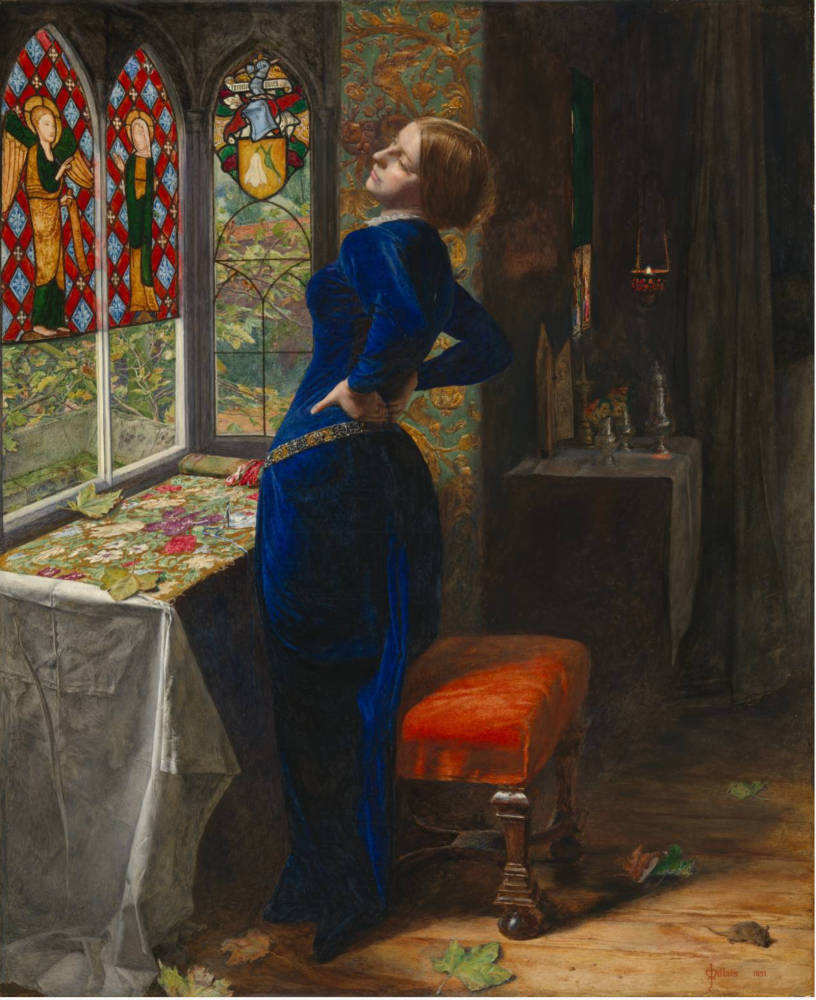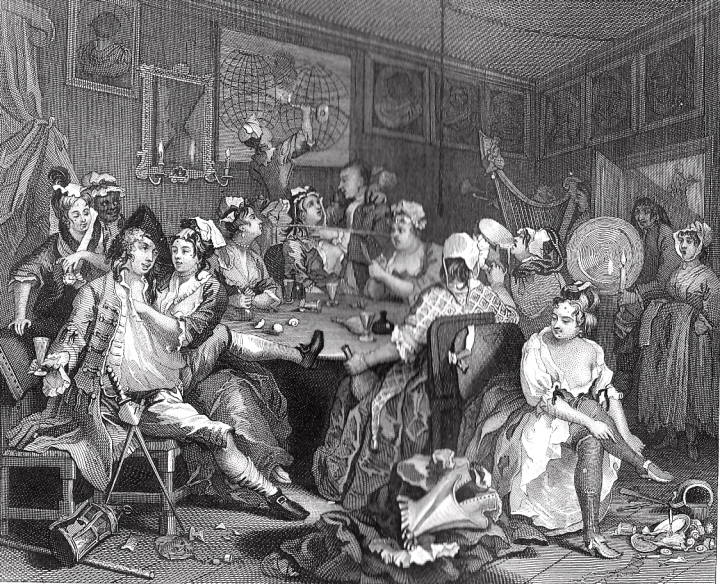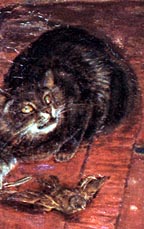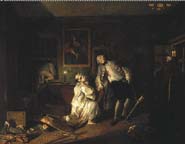
The Awakening Conscience is the most explicitly Hogarthian of his early works, in part because it makes extensive use of texts on the frame and within the picture itself. Furthermore, this painting, which may derive directly from a work by Hogarth, also depicts a contemporary moral subject, and it employs a pervasive integrated symbolism in imitation of the earlier master. Equally important, at least part of its complex intention is to view contemporary mores from the vantage point of satire. What so complicates our reaction to this companion to The Light of the World is that, although it links religious and satirical themes, it does not merge them as did The Hireling Shepherd. which is a religious satire. Instead, at the same time that it presents the young woman's moment of illumination, it satirizes her wealthy seducer.
Pre-Raphaelitism and the Pre-Raphaelite Brotherhood explains that David Copperfield had given Hunt the idea of making the conversion of a fallen woman his material embodiment of The Light of the World . "Deeply touched by the pathos of the search by Old Peggoty after little Emily,' the painter "went about to different haunts of fallen girls to find a locality suitable for the scene of the old mariner's pursuing love" (II.429). Nonetheless, Hunt explains that even at this early stage of his subject, he had decided not to illustrate any particular scene in the novel; and as he thought about this subject, he realized that a conventional dramatic encounter between father and daughter — or lover and fallen woman, as in Rossetti's Found — would not convey his intentions. "While cogitating on the broad intention,' Hunt tells us in characteristically heavy prose, "I reflected that the instinctive eluding of pursuit by the erring one would not coincide with the willing conversion and instantaneous resolve for a higher life which it was necessary to emphasise" (II.249). In other words, such a conventional recognition scene would not be psychologically accurate, since he thought that such basic changes had to come from deep within one. Further reflection brought him to the solution of his artistic problem much in the same manner that he arrived at the subject of The Light of the World. for while reading the Bible he
fell upon the text in Proverbs, "As he that taketh away a garment in cold weather, so is he that singeth songs to a heavy heart." These words, expressing the unintended stirring up of the deeps of pure affection by the idle sing-song of an empty mind, led me to see how the companion of the girl's fall might himself be the unconscious utterer of a divine message [II.429-30]
In his pictorial demonstration that God works in mysterious ways, the painter thus represents the girl's seducer as the ironically unintended means of her salvation. In singing Moore's "Oft in the Stilly Night" with her, the man unintentionally awakens "the memory of her childish home"; in response she suddenly breaks away "from her gilded cage with a startled holy resolve, while her shallow companion still sings on, ignorantly intensifying her repentant purpose" (II.430).



Three Pre-Raphaelite embowered women: Left: Mariana (1850-51) by Millais. Courtesy Tate Britain. Middle: Ecce Ancilla Domini (The Annunciation) (1849-50) by Rossetti. Courtesy of Tate Britain. Right: Mariana, Millais’s illustration for the Moxon Tennyson (1857). [Click on images to enlarge them.]
In thus depicting this religious and moral conversion to provide a realistic counterpart to the visionary Light of the World, Hunt employed the theme so dear to Tennyson and the Pre-Raphaelites which we may term "the woman inside." They frequently portrayed single figures of women within an enclosed space or room which embodies their psychological and moral condition. Tennyson's "Mariana," Millais's illustration of Mariana and Ophelia, Rossetti's Annunciation. and Hunt's Isabella and the Pot of Basil all convey a woman's state of mind by means of her physical environment.



Three Pre-Raphaelite allegorical women: Left: The Lady of Shallot (1850-51) by Hunt. Courtesy Wadsworth Atheneum, Hartford, Connecticut. Middle: Lady Lilith by Rossetti. Courtesy of the Delaware Art Museum. Right: "I Am Half-Sick of Shadows," Said the Lady of Shalott by John William Waterhouse (1915). Courtesy the Art Gallery of Ontario. [Click on images to enlarge them.]
In contrast, Tennyson's "Palace of Art,' Rossetti's Lady Lilith . Hunt's The Lady of Shalott . and its Tennysonian original employ this device to represent allegorical or mythic figures who are not literal women but aspects of humanity as a whole.
Tennyson's most important use of this device in his early poetry appears in "The Palace of Art" (text), which relates how an individual "soul" selfishly withdraws from the responsibilities of life in the manner of Huysmans's Des Esseintes. The poet constructs a series of chambers, each of which represents a state of mind or thought, and the reader is led through them until, finally, he perceives that a Palace of Art will not suffice: succumbing to the pains of isolation, Tennyson's allegorical protagonist suffers what is essentially a nervous breakdown, and this psychological trauma precipitates her realization that she must leave the confines of this enclosing artifice and live a humbler life until such time as she can lead others back to join her in the pleasures of art. Tennyson" s poem, is particularly interesting to compare to The Awakening Conscience , because although he cast his poem in the form of an allegory, he chose to detail the psychological causes and mechanism of the soul's conversion. We have no external evidence that Hunt drew upon "The Palace of Art,' but F. G. Stephens quotes the following lines from the poem when trying to convey the experience of the woman in The Awakening Conscience:
. . . in dark corners of her palace stood
Uncertain shapes; and unawares
On white-eyed phantasms weeping tears of blood,
And horrible night-mares,
And hollow shades enclosing hearts of flame,
And, with dim fretted foreheads all,
On corpses three-months-old at noon she came,
That stood against the wall. [Hunt and His Works, 35]
These horrific lines, one should point out, only convey the soul's recognition of sin and isolation, and they do not fully represent Tennyson's method of portraying spiritual illumination. Since we have no evidence from the painter himself that he consciously drew upon this poem, we can conclude only that he might have had it in mind. Stephens nonetheless helpfully reminds us that when Hunt came to paint a realistic companion piece to The Light of the World. he, like Tennyson, emphasized the psychological experience of illumination.
But whatever the painting's complex origins in Dickens, Tennyson, and Hunt's own readings in the Bible, its subject, tone, and method remain largely Hogarthian. The degree to which he had his eighteenth-century predecessor in mind when considering such subjects appears with clarity in his Reader essay on Augustus Egg. He devotes particular attention to Egg's tripartite work now known as Past and Present (see column at left), which Hunt insists should be called The Adulteress, and in defending his friend's work he frequently sounds as if he were defending The Awakening Conscience as well. Pointing out that "it is the fashion . . . to denounce all morals that are severe, particularly on this subject,' Hunt claims that Egg "determined to make a sacrifice of popularity for the principle that he felt it might illustrate" (9 January 1864, 57). Hunt's only regret was that Egg had not in the manner of Hogarth made a longer, and hence clearer narrative series. Because "it is by no means a matter of course that when a woman sins she should die in misery,' he would like the audience to perceive the mechanism of her fall depicted more fully. "Hogarth left no gap in his histories. Egg leaves us to wonder whether the erring wife was more overcome by her conscience . . . or was more imprudent than those who in daily life gather honours and worship by their wickedness. He concludes that whatever the shortcomings of Egg's paintings, they were "free from the false sentimentality" of many novels which dwell upon such vice with prurient delight (9 January 1864, 57). Now that the story of Hunt's relationship with Annie Miller is known, it seems quite possible that he was casting a sideways glance at the woman he once wanted to marry - and who apparently had profited from her "wickedness" (9 January 1864, 56).
Perhaps more important to our understanding of The Awakening Conscience (for which, incidentally, Annie Miller had originally modelled) is the likelihood that Hunt believed it a better, more Hogarthian manner of approaching this kind of moral subject. For although he was not engaged to paint a series detailing the harlot's progress, he concentrated upon the crucial moment in the woman's history.

Hogarth’s Marriage à la Mode, 5 — the Death of the Earl.
Unlike the fifth canvas of Hogarth's Marriage à la Mode, The Awakening Conscience does not require a murder for the woman to achieve self-recognition, but, like the earlier work, it is the lover who unintentionally brings about this change in her. Furthermore, Hunt's willingness to dwell upon the seducer, whom Stephens described as "a showy, handsome tiger of the human species" [Hunt and His Works, 32], may also be seen as another Hogarthian point he found lacking in Egg.


The Life of Buckingham by Augustus Egg. Courtesy of the British Art Center, Yale University.
While writing about Egg's two paintings on the life and death of Buckingham, he pointed out that "admirable" as the pictures were, they suffer from the fact that "the mind of the painter was too fastidious - too respectable to do justice to the depravity of the orgie - it would have required a Hogarth to do this." The result, argues Hunt, was that rather than creating an image of vice, Egg has presented us with "a company of merry people, well dressed, well conducted, and, for all one could see, as virtuous as any of us who eat cakes and ale" (9 January 1864, 56). although Hunt himself was not interested in duplicating the orgies of the third and sixth plates of The Rake's Progress, he did follow Hogarth in his attempt to depict the vices of his seducer.
The strong anti-aristocratic bias of The Awakening Conscience is also Hogarthian, and it is here that we can observe one of the strongest influences of The Rake's and Harlot's Progresses upon Hunt. According to Stephens, the painting represents "the interior of one of those maisons damnées which the wealth of the seducer has furnished for the luxury of a woman who has sold herself and her soul to him,' and he emphasizes that "one of his patrician arms surrounds the victim of his passions" [Hunt and His Works, 32]. Stephens places enough importance on the political implications of The Awakening Conscience that it seems reasonable to assume he is directly echoing Hunt's ideas: it is the "wealth" of a "patrician" which makes the woman a "victim."


Left: The Rake's Progress, Plate III. Right: The Harlot's Progress, Plate II.
Far more central to Hunt's symbolism than these similar attitudes towards art and morality is the fact that he employs an entire range of Hogarthian devices to convey meaning. Like Hogarth, he relies upon inscriptions, scriptural texts, and other incorporations of language within and without the design. When The Awakening Conscience was first exhibited at the 1854 Royal Academy, Hunt accompanied it in the catalogue with two scriptural texts. The first, from the Apocryphal Ecclesiasticus 14:18, can be taken to mean that human beings, like all living things, have differing fates, and can live or die spiritually as well as physically: "As of the green leaves on a thick tree, some fall and some grow; so is the generation of flesh and blood." (When the painting was originally exhibited at the 1854 Royal Academy, the catalogue mistakenly identified this passage as being from Ecclesiastes. I am grateful to Mrs. Patricia Barber for correctly identifying the source of Hunt's gloss.) The first gloss thus prepares the spectator for the painting's subject, a turning point in the woman's spiritual life. The second, which Hunt took from Isaiah, bears more directly upon the woman's confrontation with herself and Christ: "Strengthen ye the feeble hands, and confirm ye the tottering knees; say ye to the faint hearted: Be ye strong; fear ye not; behold your God." Addressing both the woman in the painting and the spectator, Hunt simultaneously offers her courage and requests the sympathy of his audience for her — and for those like her whom the spectator might encounter in real life.
On the frame Hunt placed a motto from Proverbs which functions rather differently: "As he who taketh away a garment in cold weather, so is he who singeth songs unto a heavy heart." These words comment not upon the woman, but upon her unfeeling seducer, who remains unaware how his words have oppressed her conscience and yet done her good. Furthermore, as Stephens reminds us, the emblems placed upon the frame also serve to prepare the spectator for what lies within its bounds. The ringing bells and marigolds are, respectively, "the emblems of warning and sorrow" - emblems which, again, apply to both the woman represented and the spectator alike while at the top of the frame "is set a star,' which we may assume stands for Christ or truth.


Details from The Awakening Conscience: Left: corn and the vinyard. Right: Painting of Christ and the women taken in adultry. [Click on images to enlarge them.]
Furthermore, in his attempt to make all the details of this picture assist in conveying his tale of great spiritual change, Hunt, again following Hogarth, has included paintings that echo or comment upon the main theme. As Stephens points out, "The very decorations on the wall are significant, and might have suggested repentance before. They bear a vineyard, in which corn is mingled with the vine; birds destroy the grapes of the latter, while at the foot sleeps a boy-guardian, whose horn, fallen from his hand, indicates neglected duty" [Hunt and His Works, 34]. In addition to this tapestry, which obviously echoes The Hireling Shepherd, Hunt also included a painting over the fireplace which, as Ruskin points out, depicts a "single drooping figure the woman taken in adultery" [Works, 12.335]. In making use of these Hogarthian touches, Hunt, one may note, has slightly sacrificed his realistic intention to reinforce his meaning: it is unlikely, certainly, for the kept woman to have hung such a painting above her mantel or to have taken much solace in it — unless it were from the fact that Christ forgives all and warns none of us to cast the first stone. Such an ingenious explanation, however, seems beyond the capacity of Hunt's intended heroine, and the picture on the mantel has an element of obvious artificiality which Hunt does not later employ.


Left: The cat toying with the bird in The Awakening Conscience. Dürer's engraving of the Young Woman Attacked by Death (The Ravisher). Courtesy the British Museum.
Unlike the picture and the tapestry, the cat which, unnoticed by either figure, is toying with a helpless bird, functions in a more natural, if no less Hogarthian manner. As Stephens suggests, the image of the "false, pitiless, and cruel" seducer is the cat, "which, having brought a living bird into the room, grants short respite to it, because the singing has disturbed her purpose of destruction" [Hunt and His Works, 34]. This rather blatant symbol of the man also serves to suggest how harsh will be the young woman's fate, how painful her return to virtue. Macmillan has proposed that Hunt drew upon Hogarth's The Lady's Last Stake for The Awakening Conscience (195.197), but Dürer's engraving of theYoung Woman Attacked by Death (The Ravisher) is an even more likely source: not only is the disposition of the two figures much closer, but the main theme of The Awakening Conscience appears in Dürer's engraving, for in Hunt's view the seducer is an embodiment of death from whose arms she must struggle to reach Christ and new life.
Finally, as both Ruskin and Stephens point out, the room's gaudy, vulgar furnishings serve not only to indicate the woman's present position in society but also the moral and aesthetic values of both seducer and seduced. When this young woman flees her enclosing room, she will be leaving not a Palace of Art but one of vulgarity. We perceive how false have been the values by which she has lived until now. Looking at this room from the perspective of aesthetic and political statements Hunt made elsewhere, we perceive an indictment of the upper classes who have used their wealth to create precisely this kind of heartless surroundings for their victims. Thus, like Ruskin's Stones of Venice and "Traffic" (text), The Awakening Conscience claims that taste speaks to the entire human being, and that therefore the moral nature of a man, class, and society appear in the arts they choose. Hunt, who frequently accused the rich of encouraging only the worst in art and general taste, concluded his memoir with the affirmation that "the purpose of art is, in love of guileless beauty, to lead man to distinguish between that which, being clean in spirit, is productive of virtue, and that which is flaunting and meretricious and productive of ruin to a Nation" (II.493). Here in this early work he is using, not love of beauty, but the satirist's devices to enable his audience to discern what is clean in spirit.
I would therefore argue that Macmillan is incorrect in denying that Hunt was ever a satirist. According to him , the chief importance of Hogarth to Hunt was in the use of modern moral subjects, and the Pre-Raphaelite never shared his predecessor's satiric emphasis:
The difference between Hunt and Hogarth is that the former sought to be effective not through satire and through irony, but through exhortation and demonstration of what seemed to him the fundamental truths. Unlike Hogarth's works, his pictures are not aimed at particular aspects of social behavior, but instead make general moral propositions. This is why the Awakening Conscience . . . is as much a metaphor of a universal spiritual risk as a particular tract for the redemption of fallen women. It is more a religious picture than a piece of social commentary.
No one would deny that The Awakening Conscience is more a religious painting than one concerned primarily with social commentary, satiric or otherwise; but for Hunt the two intentions are not necessarily opposed. Certainly, the powerful satiric analogies present in The Hireling Shepherd and Our English Coasts show Hunt making use of irony, while the more detailed satire of The Awakening Conscience serves both political and social commentary. True, in each picture satire is only part of Hunt's complex intention, and in that part he turned to Hogarth for instruction. Hunt's friends also saw him as occasionally playing the role of the satirist. While he was at work on The Shadow of Death his friend Tupper wrote describing some "palpable Pecksniff," and urged him: "Come here quickly and paint some pictures in the modern vein like "The Awakening Conscience" — something — anything by way of a looking glass for these times " (26 April 1872; Rugby Huntington MS). But once Hunt found his major interest in scriptural subjects, he did not take time to hold the satirist's mirror up to his society, and when he did paint another work with satiric elements its subject was taken from the Middle East.
Created 2001; last modified 28 October 2020





